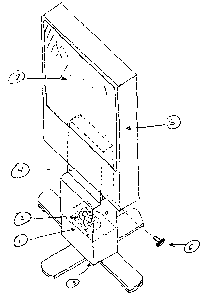Une partie des informations de ce site Web a été fournie par des sources externes. Le gouvernement du Canada n'assume aucune responsabilité concernant la précision, l'actualité ou la fiabilité des informations fournies par les sources externes. Les utilisateurs qui désirent employer cette information devraient consulter directement la source des informations. Le contenu fourni par les sources externes n'est pas assujetti aux exigences sur les langues officielles, la protection des renseignements personnels et l'accessibilité.
L'apparition de différences dans le texte et l'image des Revendications et de l'Abrégé dépend du moment auquel le document est publié. Les textes des Revendications et de l'Abrégé sont affichés :
| (12) Demande de brevet: | (11) CA 2485327 |
|---|---|
| (54) Titre français: | EPURATEUR D'AIR PORTATIF POUR POSTE DE TRAVAIL |
| (54) Titre anglais: | PORTABLE BREATHING ZONE AIR CLEANER |
| Statut: | Réputée abandonnée et au-delà du délai pour le rétablissement - en attente de la réponse à l’avis de communication rejetée |
| (51) Classification internationale des brevets (CIB): |
|
|---|---|
| (72) Inventeurs : |
|
| (73) Titulaires : |
|
| (71) Demandeurs : |
|
| (74) Agent: | |
| (74) Co-agent: | |
| (45) Délivré: | |
| (22) Date de dépôt: | 2004-11-18 |
| (41) Mise à la disponibilité du public: | 2006-05-18 |
| Licence disponible: | S.O. |
| Cédé au domaine public: | S.O. |
| (25) Langue des documents déposés: | Anglais |
| Traité de coopération en matière de brevets (PCT): | Non |
|---|
| (30) Données de priorité de la demande: | S.O. |
|---|
The objective of this invention is to provide a means of reducing personal
exposure indoors
to certain airborne contaminants including particulates and chemicals
including those
given off or generated by the individual or by his activities and thus avoid
subsequent
symptoms caused by inhaling these materials. The invention is for use indoors
by
individuals with hypersensitivity to certain airborne contaminants. This
invention provides
a solution to the problem of reducing human exposure to suspended particles
and other
airborne contaminants in indoor air that a person breathes. The invention is
an air
filtering/cleaning device that creates a region of slow laminar flow of clean
air in front of
the outlet of the filter, directing clean air to the user's breathing zone.
The filter is for use
by persons in bed or in a sitting location such as a desk or sofa. The slow,
laminar flow
does not cause discomfort to the user and at the same time displaces
contaminated room air
from the user's breathing zone.
Note : Les revendications sont présentées dans la langue officielle dans laquelle elles ont été soumises.
Note : Les descriptions sont présentées dans la langue officielle dans laquelle elles ont été soumises.

2024-08-01 : Dans le cadre de la transition vers les Brevets de nouvelle génération (BNG), la base de données sur les brevets canadiens (BDBC) contient désormais un Historique d'événement plus détaillé, qui reproduit le Journal des événements de notre nouvelle solution interne.
Veuillez noter que les événements débutant par « Inactive : » se réfèrent à des événements qui ne sont plus utilisés dans notre nouvelle solution interne.
Pour une meilleure compréhension de l'état de la demande ou brevet qui figure sur cette page, la rubrique Mise en garde , et les descriptions de Brevet , Historique d'événement , Taxes périodiques et Historique des paiements devraient être consultées.
| Description | Date |
|---|---|
| Le délai pour l'annulation est expiré | 2009-11-18 |
| Demande non rétablie avant l'échéance | 2009-11-18 |
| Inactive : Demande ad hoc documentée | 2009-08-20 |
| Réputée abandonnée - omission de répondre à un avis sur les taxes pour le maintien en état | 2008-11-18 |
| Lettre envoyée | 2007-02-13 |
| Exigences de rétablissement - réputé conforme pour tous les motifs d'abandon | 2007-01-26 |
| Réputée abandonnée - omission de répondre à un avis sur les taxes pour le maintien en état | 2006-11-20 |
| Demande publiée (accessible au public) | 2006-05-18 |
| Inactive : Page couverture publiée | 2006-05-17 |
| Inactive : CIB en 1re position | 2005-01-13 |
| Exigences de dépôt - jugé conforme | 2004-12-14 |
| Demande reçue - nationale ordinaire | 2004-12-14 |
| Inactive : Lettre officielle | 2004-12-14 |
| Inactive : Certificat de dépôt - Sans RE (Anglais) | 2004-12-14 |
| Déclaration du statut de petite entité jugée conforme | 2004-11-18 |
| Date d'abandonnement | Raison | Date de rétablissement |
|---|---|---|
| 2008-11-18 | ||
| 2006-11-20 |
Le dernier paiement a été reçu le 2007-10-15
Avis : Si le paiement en totalité n'a pas été reçu au plus tard à la date indiquée, une taxe supplémentaire peut être imposée, soit une des taxes suivantes :
Veuillez vous référer à la page web des taxes sur les brevets de l'OPIC pour voir tous les montants actuels des taxes.
| Type de taxes | Anniversaire | Échéance | Date payée |
|---|---|---|---|
| Taxe pour le dépôt - petite | 2004-11-18 | ||
| TM (demande, 2e anniv.) - petite | 02 | 2006-11-20 | 2007-01-26 |
| Rétablissement | 2007-01-26 | ||
| TM (demande, 3e anniv.) - petite | 03 | 2007-11-19 | 2007-10-15 |
Les titulaires actuels et antérieures au dossier sont affichés en ordre alphabétique.
| Titulaires actuels au dossier |
|---|
| SAUL STRICKER |
| Titulaires antérieures au dossier |
|---|
| S.O. |